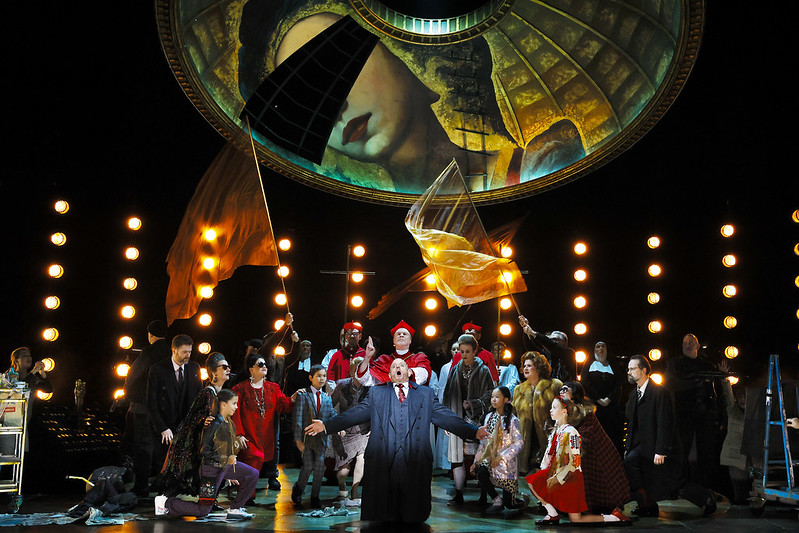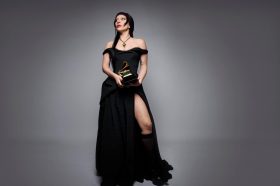Mainstage production companies are having a hard time finding a venue in Melbourne at the moment, given the Arts Centre’s renovations, so it’s unsurprising Opera Australia is using Margaret Court Arena to stage its production of Tosca, directed by Edward Dick.
What is surprising is the proscenium arch stage transplanted into the arena fails to respond to the sinews and materials of the space. It feels like a missed opportunity and is reminiscent of a makeshift theatre hobbled together in the hall of an underfunded public school.
This niggling sense of amateur theatre is swept away when the lights go down and a dramatic tableau is presented to the audience – recently escaped freedom fighter Angelotti (David Parkin) climbing down a rope that hangs through the top of a church’s dome. His arrival, seeking help from fellow comrade Cavaradossi (Diego Torre), is the catalyst for the tragic series of events that follow.
The set, designed by Tom Scutt, is stark. The church dome, changing position each act is the focal point and is reminiscent of staging seen in Wagner’s Ring Cycle. This emptiness sees lighting designer Lee Curran utilise different forms of lighting to create visual intrigue. From torches to the large light shining through the dome, to spotlights that differentiate between Scarpia (Robert Hayward) the villain in cool lighting and the heroes Tosca (Karah Son) and Cavaradossi in warm.
This works best in Act Three, when the dome becomes an ominous prison wall and the hole in the middle the perfect place for Tosca to cut an imposing figure, light shining behind her as she falls to her death. The scale feels grandiose.
The preceding act is the exact opposite. There is so much furniture on the stage that it becomes a hindrance for the performers. More egregiously, their faces are nearly entirely in shadow, the only light coming from directly above Scarpia’s bed, which fails to reach to the edges of the stage.
One hopes this was an opening night technical issue with the arena’s spotlights, because the result was a near inability to discern the performers’ facial features while they were in the throes of passion, despair or rage.
Son’s sequinned dress catches the light more than her face, so it is lucky her decisive and unrestrained physicality pushes Tosca’s feelings out to the audience. It is refreshing to see a performance that doesn’t shirk away from the ungainly movements that occur when experiencing and responding to violence. Son’s characterisation of the character is similarly unique in that she depicts Tosca, a beloved singer, as an old school diva, demanding and dramatic in all aspects of life while still sincere.
Given the arena space, the performers wear microphones, which sees their high level of musicianship often become lost in the dense curtains covering half the arena. Still, it’s clear Son and Diego Torre, performing the role of Tosca’s lover Cavaradossi, have ample technical prowess. The orchestra rarely captures attention, for similar reasons.
Read: Performance review: FAKE, The Rechabite
The performance, while not overstaying its welcome, is a reminder that the magic and grandiose nature of opera comes from the ability for one or a few voices to float over the top of the orchestra pit and into the seats up in the gods.
Tosca
Margaret Court Arena
Conductor: Garry Walker
Director: Edward Dick
Set Designer: Tom Scutt
Costumer Designer: Fotini Dimou
Choreographer: Maxine Braham
Sound Designer: Jim Atkins
Lighting Designer: Lee Curran
Fight Designer: Blake Wells
Lighting Assistant: Jason Morphett
Assistant Director: Warwick Doddrell
Cast: Karah Son and Nadine Benjamin MBE (alternating the role of Tosca), Diego Torre and Young Woo Kim (alternating Cavaradossi), Robert Hayward and Warwick Fyfe (alternating the role of Scarpia), Benjamin Rasheed, Luke Gabbedy, David Parkin, Andrew Moran, Anthony Mackey, Hugh Ling, Eleanore Morgan
Tickets: from $59
Tosca will be performed until 30 May 2024.




